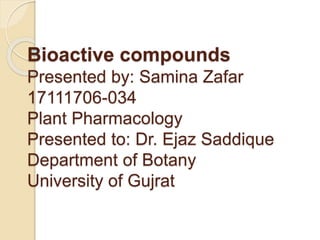
Bioactive...034
- 1. Bioactive compounds Presented by: Samina Zafar 17111706-034 Plant Pharmacology Presented to: Dr. Ejaz Saddique Department of Botany University of Gujrat
- 2. A bioactive compound is any compound present in the foods of humans, animals, or plants that has an effect on the organism consuming it. Caffeine for example, would be a bioactive compound of coffee.
- 3. Other types of bioactive compounds are: flavonoids, carotenoids, carnitine, choline, coenzyme Q, creatine, dithiolthiones, phytosterols, polysaccharides, phytoestrogens, glucosinolates, polyphenols, anthocyanins, Prebiotics taurine
- 4. Bioactive compounds can cause numerous effects; they can stimulate, cause anxiety, or intoxicate. There are even some bioactive compounds that are known to increase the side effects of certain medicines.
- 5. Bioactive Principles from Medicinal Plants Bioactive principles are derived from the products of plant primary metabolites, which are associated with the process of photosynthesis. the chemical diversity and medicinal potentials of bioactive principles as well inherent toxicity concerns associated with the use of these plant products, which are of relevance to the clinician, pharmacist or toxicologist.
- 6. Plant materials are composed of vast array of bioactive principles of which their isolation, identification and characterization for analytical evaluation requires expertise with cutting edge analytical protocols and instrumentations.
- 7. Bioactive principles are responsible for the therapeutic activities of medicinal plants and provide unlimited opportunities for new drug leads because of their unmatched availability and chemical diversity. For the most part, the beneficial or toxic outcomes of standardized plant extracts depend on the chemical peculiarities of the containing bioactive principles.
- 8. Biosynthetic pathways leading to synthesis of secondary metabolites
- 9. Shikimic acid pathway leading to the biosynthesis of diverse bioactive principles
- 10. Alkaloid They are diverse low-molecular- weight, cyclic organic compounds containing nitrogen in a negative oxidation state. Alkaloids belong to the broad category of alkaline secondary metabolites that constitute the pharmacologically bioactive principles that are predominant, but not exclusively present, in flowering plants.
- 11. Alkaloids are synthesized from decarboxylation of amino acids to produces amines, which react with amine oxides to form aldehydes. The Mannich-type condensation of the aldehydes and amine groups yield characteristic heterocyclic rings of alkaloids.
- 12. The chemical nature of their nitrogen ring serves as basis for the sub- classification of alkaloids: For instance, glycoalkaloids is the aglycone moiety that is glycosylated with a carbohydrate.
- 13. Few alkaloids occur as glycosides of sugar such as glucose, rhamnose and galactose, whereas some weak basic alkaloids (nicotine) occur freely in nature Others as amides (piperine) and esters (atropine, cocaine) of organic acids.
- 14. Flavonoid The bioflavonoid are collections of low molecular weight phenolic groups of phytochemicals that include the anthocyanins (e.g., cyanidin, petunidin), The flavonols (quercetin, kaempferol) Flavones (luteolin, apigenin) Flavanones (myricetin, hesperetin,) Flavan-3-ols (catechin, gallocatechin) Isoflavones (genistein, daidzein)
- 15. Flavonoids are widely distributed in the plant kingdom and have been reported to exhibit strong antioxidant activity. Flavonoids are plant pigments and for the most part, are responsible for display marvelous colours of flower petals and the emission of brilliant fluorescence when green plant cells are excited by UV light
- 16. Common flavonoids including: quercetin kaempferol The tubers and root of Aconitum Aconitum napellus are particularly rich in β-3, 4-dihydroxyphenethyl β- glucopyranoside.
- 17. Anthocyanins The anthocyanins are the most important and widespread group of colouring matters in plants. These intensely coloured water soluble pigments are responsible for almost all the colours of petals, leaves and fruits of plants.
- 18. Saponins Saponins are a family of amphipathic glycosides in which the varied number sugar moieties are bound to a ‘sapogenin-steroid alkaloids, steroids or triterpene resulting to structural varieties of saponins, which serves as basis for their classification
- 19. Soybean, lupins and several other legumes are rich sources of triterpene saponins Dietary saponins reduce protein digestibility and obstruct the absorption of micronutrients Saponins exhibited hypoglycemic, anti-peroxidative and anti- hyperlipidemic effects in Type I diabetes.
- 20. Tannins Tannins or tannic acid are water- soluble polyphenols that are present in many plant foods. Tannins are bitter astringent, condensed or hydrolysable polyphenolic compounds Bind to and precipitate proteins and other various organic compounds including amino acids and alkaloids
- 21. Glycosides Glycosides are found in virtually every medicinal plant and have vast therapeutic efficacy Certain cases, toxic effect depending on the plant of origin and the dose of plant product ingested.
- 22. The most encountered glycosides of medicinal and toxicological importance are the vitamins glycosides, polyphenolic glycosides (anthraquinone glycosides), alkaloid glycosides, glycosides in the group of antibiotics (streptomycin), glycopeptides, cardiac glycosides, steroid terpenoid glycosides, cyanogenic glycosides etc
- 23. Terpenoids Terpenoids are derived from five carbon isoprene units that are assembled in numerous combinations to generate vast arrays of terpene derivatives, collectively referred to as isopreniods. Most terpenoids are present in the glycosidic form rather than the non- polar or low polarity terpene aglycone form
- 24. Notable examples include: mono- and sesquiterpene volatile derivatives from Antirrhinum tortuosum mono- and sesquiterpenes from Phlomis fruticosa saponins and sapogenins from Asparagus aphyllus sesquiterpene lactones from Palaeocyanus crassifolius